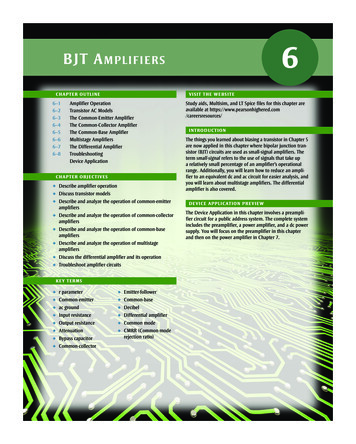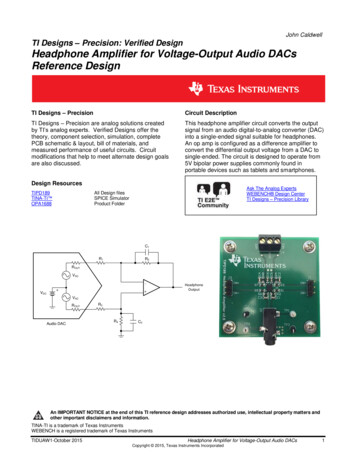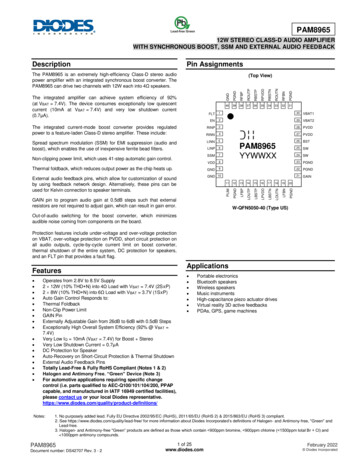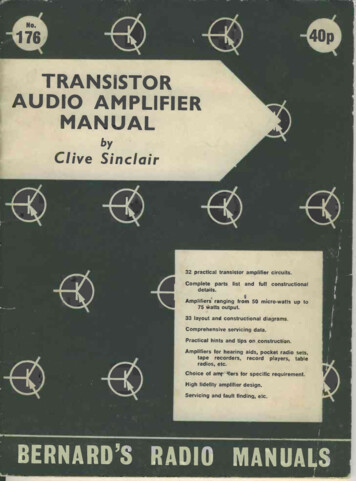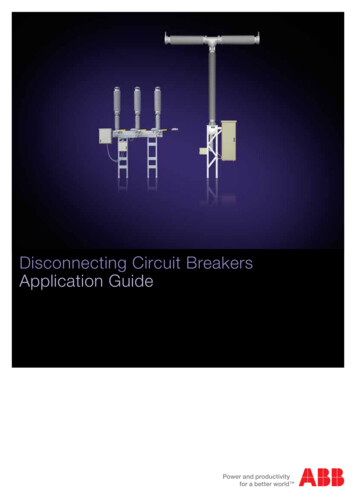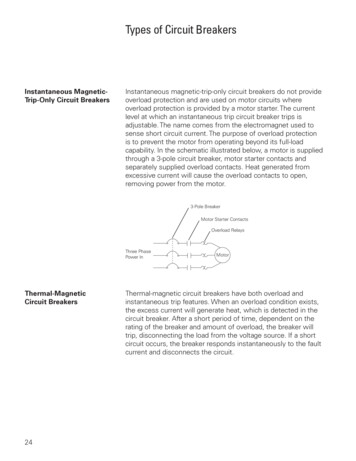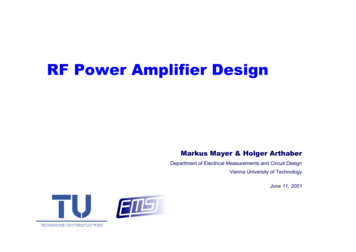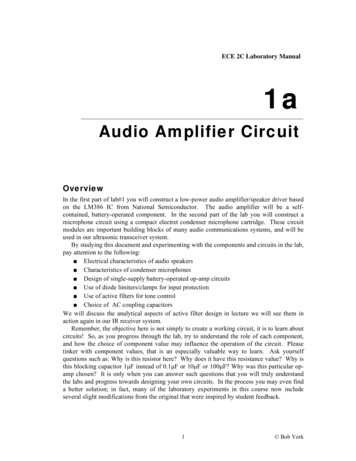
Transcription
ECE 2C Laboratory Manual1aAudio Amplifier CircuitOverviewIn the first part of lab#1 you will construct a low-power audio amplifier/speaker driver basedon the LM386 IC from National Semiconductor. The audio amplifier will be a selfcontained, battery-operated component. In the second part of the lab you will construct amicrophone circuit using a compact electret condenser microphone cartridge. These circuitmodules are important building blocks of many audio communications systems, and will beused in our ultrasonic transceiver system.By studying this document and experimenting with the components and circuits in the lab,pay attention to the following: Electrical characteristics of audio speakers Characteristics of condenser microphones Design of single-supply battery-operated op-amp circuits Use of diode limiters/clamps for input protection Use of active filters for tone control Choice of AC coupling capacitorsWe will discuss the analytical aspects of active filter design in lecture we will see them inaction again in our IR receiver system.Remember, the objective here is not simply to create a working circuit, it is to learn aboutcircuits! So, as you progress through the lab, try to understand the role of each component,and how the choice of component value may influence the operation of the circuit. Pleasetinker with component values, that is an especially valuable way to learn. Ask yourselfquestions such as: Why is this resistor here? Why does it have this resistance value? Why isthis blocking capacitor 1μF instead of 0.1μF or 10μF or 100μF? Why was this particular opamp chosen? It is only when you can answer such questions that you will truly understandthe labs and progress towards designing your own circuits. In the process you may even finda better solution; in fact, many of the laboratory experiments in this course now includeseveral slight modifications from the original that were inspired by student feedback.1 Bob York
2Audio Amplifier CircuitTable of ContentsPre-lab PreparationBefore Coming to the LabSchedule for Lab #1Parts ListFull Schematics for Lab #1Background informationAudio SpeakersIn-Lab Procedure1.1Some comments on our choice of ICsWhy the LM386?Why the LM358?1.2Speaker Equivalent Circuit1.3Assemble Amplifier on Breadboard1.4Summing network1.5Optional -- Tone-Control Circuit1.6Hardwire the Amplifier1.7Possible Improvements222346688889911121314Pre-lab PreparationBefore Coming to the Lab Read through the lab experiment to familiarize yourself with the components andassembly sequence. Before coming to the lab, each group should obtain a parts kit fromthe ECE Shop. With reference to the full schematic in Figure 1-1 calculate the lower cutoff frequencyimposed by capacitors C1-3 and R1-3 in the summing network:flow HzSchedule for Lab #1To stay on schedule, you must do the following: Week #1:Audio amplifier Week #2:Microphone circuitThe audio amplifier project is more difficult and time-consuming than the microphone preamp, so part of week #2 may be used to finish the audio amp. All breadboarding and testingcan and should be done in lab. Soldering and hardwiring can and should be done outside lab. Bob York2
3Pre-lab PreparationParts ListAudio AmplifierQty udio Speaker, 8-Ohm, 2 Watt, 0.3-9KHzLM386N-3 Low-Voltage Audio Power AmpliferLM358 Low-Power Dual Op-Amp8-pin low-profile IC socket10 Ohm 1/2W resistor2.2k 1/4W resistor10k 1/4W resistor100k 1/4W resistor10k trimpot20k trimpot470 uF 16V electrolytic capacitor (PC lead)100uF 16V electrolytic capacitor (PC lead)10uF 16V electrolytic capacitor (PC lead)1uF capacitor0.033uF capacitor (CK05 low-voltage ceramic )0.022uF capacitor (CK05 low-voltage ceramic )0.1uF capacitor (CK05 low-voltage ceramic )1N4148 small-signal Silicon diode4.5" x 5.67" vectorboardRubber feetStereo Audio jack3.5mm male-to-male stereo patch cord9V battery leads9V battery holder (adhesive backed)9V batteryDoubled-sided adhesive tape for mounting speakerflea clips#22 stranded wire (black)#22 stranded wire 4,C6C1,C2,C3,C5C7C11,C12C8 Bob York
4Audio Amplifier CircuitFull Schematics for Lab #1Figure 1-1 – Schematic for the basic audio amplifier. Bob York4
5Pre-lab PreparationFigure 1-2 – Schematic for the audio amplifier with optional tone-control circuit.5 Bob York
6Audio Amplifier CircuitBackground informationAudio SpeakersAudio speakers convert electrical signals into mechanical motion. The most commonspeakers for high-quality audio are constructed as shown in Figure 1-3 . The electric signal ispassed through a coil of wire (the “voice” coil), which is suspended a strong magnetic fieldprovided by a permanent magnet. A time-varying current in the coil leads to a mechanicaldeflection relative to the magnet. The coil is attached to a lightweight conical membrane(usually made from a heavy-grade paper) that couples the mechanical motion of the coil tothe surrounding air molecules.ResonanceBand ofoperation(a)(b)Figure 1-3 – (a) Cross section and (b) Impedance curve for a typical 8 dynamic speaker.If you look through catalogs of audio-speakers, you will find many different sizes andprice ranges. For example, check out http://www.tb-speaker.com/tbp.htm. High-quality audiospeakers can be quite expensive, and are designed for a flat, omni-directional frequencyresponse in the specified operating range. Small inexpensive speakers, such as the ones usedin this lab, have poor low-frequency response and limited power-handling capacity.Speakers are commonly specified by their frequency response, impedance level, andpower-handling capacity. Typical speaker impedances are “8 ” or “4 ” or “16 ”. This isoften a source of confusion because it suggests the speaker is modeled by a constantresistance of this value. In reality there is a significant reactive component of impedance andhence a strong variation of impedance with frequency, as shown in the figure above. Theimpedance can also depend strongly on the surroundings. For example, a speaker measured inisolation (the “free-air” response) will have a different impedance than one mounted in awooden enclosure. D. B. Weems, Designing, Building & Testing your Own Speaker System, Tab Books: Blue RidgeSummit, PA, 1984 Bob York6
7Background informationThe AC impedance often displays at least one resonance, relating to the size and stiffness(“compliance”) of the cone. Electrically this mechanical resonance can be modeled by aparallel RLC circuit. The operating frequency rangeRcLcfor the speaker begins at or above this resonance, andin this range the speaker impedance is well modeled byjust a resistance in series with an inductance. Theinductance comes from the voice coil itself. Theresistance term is largely the DC resistance of theLmCmRmvoice coil, with a small additional contribution whichrepresents energy conversion to mechanical motion.The combination of the two resistances is usually closeto the specified impedance of the speaker (e.g. 8 ) inFigure 1-4 – Equivalent circuit for anthe middle of the operating range.audio speakerA pretty good equivalent circuit model for anyspeaker is shown in Figure 1-4 and can be created by measuring or finding the followingparameters: DC Resistance of the voice coil, RcFree-air resonant frequency, fsInput resistance Rt at f fs (the impedance is purely resistive at resonance)Bandwidth Δf of the resonance (between the points where Z t Rt / 2 ). The Qfactor is then Qms fs /ΔfInductance Lc of the voice coil (measure at a high frequency, f fs)The free-air mechanical resonance is modeled by a parallel RLC circuit. Since the Q-factorof a parallel resonator is Qms RC , and the resonant frequency is f s 1/ 2 LC , theequivalent circuit parameters can be found asQms1Rm Rt Rc Cm Lm 2 f s Rm(2 f s ) 2 CmOne last point about speakers: for a single-speaker application the polarity of the speakeris irrelevant. However, if multiple speakers are used, it is important to connect them togetherwith the correct polarity so that the voice coils and cones will move in phase with each other.For this reason, speaker terminal are often designated with a “ ” or “-” symbol.7 Bob York
8Audio Amplifier CircuitIn-Lab Procedure1.1 Some comments on our choice of ICsWhy the LM386?At first glance this project looks simple; all we need is an amplifier to drive an audio speaker,right? Why not just use a simple op-amp gain stage? Well, one immediate challenge is thatspeakers have a low impedance, typically 8-Ohm. Even for a low-power 0.5W audioamplifier, P I 2 R / 2 requires that the amplifier must be able to source a peak AC current ofaround 350 mA with an 8-Ohm load. This is a lot more than a typical op-amp is designed toprovide. For example, the LM358 and LF353 (two op-amps used in this lab) can sourcearound 20-40mA at most. So we need a device that can handle higher currents. We alsowant a device that can be operated from a single supply voltage (a battery in this case). It ispossible to make a suitable amplifier using an op-amp and a couple of external powertransistors, but we went with a simpler solution, and chose a chip that was specificallydesigned as an audio driver, the LM386, shown in Figure 1-5.Figure 1-5 – LM386 internal circuit and 8-pin DIP pin assignments.This is an old chip that has been a popular choice for low-power audio applications formany years. There are many other audio amp ICs on the market (LM380 and LM383 aresimilar but higher-power amps from National), but the LM386 is sufficient for our purposes.It comes in three-flavors, the LM386-1, LM386-2, and LM386-3, which can provide 0.3W,0.5W, and 0.7W respectively, more than adequate for this lab. Another nice thing about theLM386 is that the gain-frequency curve can be shaped with some external feedbackcomponents, so it is a very flexible device. If you do a web search on “LM386”, you willfind many examples of clever circuits that people have come up with over the years. The onein this lab is a minor modification of a circuit described in the data sheet.Why the LM358?For the remainder of the circuit (a simple unit-gain summing network) we have chosen anLM358 op-amp, which is a low-power device that can be operated from a single voltagesupply, therefore appropriate for battery-operated circuits. Low-power op-amps draw verylittle quiescent current and hence help prolong the life of the battery. The LM358 is agarden-variety op-amp and there are many other possibilities that could be used, but this oneis very cheap! We also chose a dual device in case you choose to do the optional tone-control Bob York8
9Speaker Equivalent Circuitcircuit. It doesn’t matter which of the two internal op-amps you use for the summing networkor the tone-control circuit, they are identical.1.2 Speaker Equivalent CircuitWe’ll start by measuring the characteristics of the audio speaker in your kit. This is a small,general-purpose speaker used for intercoms and other inexpensive audio systems.For these measurements, it is important to keep the speaker face-up. Using the R-L-C meter in the lab, measure the coil resistance and coil inductance (themeter uses a frequency that is well above the speaker’s mechanical resonance).Now we’ll use the function-generator at your workstation to drive the speaker. Since thespeaker has a small impedance, we must be careful to keep the amplitude of the functiongenerator low so that it doesn’t have to source a lot of current. Adjust your functiongenerator to produce a sinusoidal wave with an AC amplitude of Vg 200 mV and zeroDC offset.Electrically connect yourRspeaker to the functiongenerator as shown in Figure 1-6, using a smallVV VL resistor R in series withgLZ R the speaker (something Vg VL around 50 , or two 100 resistors in parallel, seems Z to work well).ThisFigure 1-6 – Speaker test circuitcreates a voltage divider,so that the voltage across the speaker is proportional to the magnitude of its impedance.Thus by measuring Vg and VL we can map out the variation of impedance with frequencyusing the formula in Figure 1-6.Find the resonant frequency (somewhere in the range of 100-200 Hz), and record theimpedance at resonance and the bandwidth. Then compute the equivalent circuitparameters as discussed in the background information.1.3 Assemble Amplifier on BreadboardThe schematic for an LM386-based amplifier is shown in Figure 1-7. We will first constructthis amplifier using your plastic solderless breadboard and bench power supply. Once youdebug the circuit and demonstrate that it works properly, you will “hard-wire” it onto avectorboard and power it from a 9V battery. The idea of breadboarding the circuit first is notto create more work! It is good practice in general, since it allows you to debug your designmore easily, allows you to experiment with component values, and most importantly will helppreserve your battery in the event of a wiring error! The battery is in fact one of the mostexpensive components in this lab.9 Bob York
10Audio Amplifier CircuitFigure 1-7 – Schematic of LM386 Amplifier. First study the schematic carefully, and locate all the necessary parts in your kit. Findthe LM386 chip and compare it with Figure 1-5 and the schematic in Figure 1-7 tocorrelate pin numbers with the circuit connections.Configure your breadboard with connections to the power supply and appropriate wiringto the power busses, then add the LM386 IC and make the power (pin 6) and ground (pin4) connections as shown in the schematic. Add the 100μF and 10μF bias/bypasscapacitors.With reference to the schematic, add in the resistor and capacitor elements as shown.Note the role of each component:1. 1 F capacitor: DC blocking, AC couples the input signal2. 10k trimpot: voltage-divider for volume control3. 10 F capacitor: Internal AC bypass (see data sheet).4. 10k resistor and 33nF capacitor between pins 1-5: bass-boost feedbackcircuit (see data sheet), helps compensate for the poor low-frequencyresponse of our speaker5. 470 F capacitor: DC blocking (why is this so large compared with otherblocking/bypass capacitors?)6. 10 resistor and 0.1 F capacitor: a “snubber” circuit for high-frequencystabilization, prevents potential oscillation due to inductive loading.Add in the back-to-back diodes at the input terminal of the device. These diodes clampthe input voltage on pin 3 at /- 0.7 V, to insure that excessive voltage is never applied tothis pin, which could damage the circuit.Add the speaker. You will need to first solder wire jumper leads to the speaker terminals.You are now ready to test the circuit as shown in Figure 1-8. First connect your bench function generator to the oscilloscope and adjust for a 1kHzsinewave with a 0.2 V amplitude, and verify on the oscilloscope. Then apply this signalto your amplifier along with the 9V bias. If all goes well, you should hear a tone.Adjust the volume control as necessary. Bob York10
11Summing network With the volume adjusted to a reasonable level, sweep the frequency to determine thelowest and highest audible tones and record your data.Observe the output waveform at pin 5on the oscilloscope for a 0.5VFunctionPower Supplyamplitude input at 1 kHz. Note that theGeneratoroutput is level shifted to approximatelySpeakerhalf the power supply voltage. Canyou see distortion as the volume is 9 Vincreased? Why is this happening?AmplifierRemove the LM386 temporarily andCircuitapply a 1V sinusoid at 1 kHz to theamplifier input and observe theFigure 1-8 – Testing the amplifier circuitwaveform at pin 3 under full-volumeconditions. You should observe theclamping or limiting action of the input diodes. Record this waveform.Reconnect the IC and speaker and insert the bench multimeter in series with the powersupply as shown above to measure the DC current flow into the amplifier. Record thecurrent under the operating conditions.1.4 Summing networkThe next step is to add the summing network, which is used to combine several audio inputsinto a common output signal. For example, if we want to hook our “mono” amplifier to a“stereo” signal, such as produced by an MP3 player or CD player, then we need to add theleft and right stereo channels together so that the amplifier can amplify both simultaneouslyand deliver them to the speaker.Add the summing circuit as shown in Figure 1-9. Just put in the AUX channel for now(C3-R3), don’t worry about the stereo jack and associated RC elements, those can beadded in the hardwired versionStereo Input Jack C1R131uF-POL10k R4C2R210k 1uF-POL10k 21 C3Aux Input4R310k 1uF-POLLM358AN2U1A13R510k 8VCCVCCSets reflevel atVcc/29V9VR6100k C410uF-POLR7100k Figure 1-9 – Single-ended unity-gain summing network and LM358 pinout11 Bob York
12Audio Amplifier CircuitThere are two important points to understand here, both of which are related to the use of asingle (battery) supply. First, in the textbook dual-supply op-amp summing circuit, thepositive (non-inverting) input is usually grounded. The voltage at this pin defines the“reference” voltage for the input signals, which is the desired average or DC output level inan audio system. We usually choose this level to maximize the possible AC voltage swing,hence it should be midway between the two supply voltages. For a dual (bipolar) supply, thiswould be ground (0 V), but for our 9V battery supply, it is half the supply voltage, or 4.5Volts. This is accomplished using the two 100k resistors in a voltage divider (we choose100k resistors here to minimize the current draw from the battery). The 10 F bypasscapacitor helps prevent this voltage level from fluctuating during operation, maintaining aconstant potential and hence a good AC ground.Secondly, since the input and outputs of this summing network will be capacitivelycoupled, the data sheet recommends adding an external resistive DC current path to ground atthe output of the op-amp, to increase the bias current through the transistors in the op-amp’soutput stage during operation. This is what R5 is for. You’ll have to wait until ECE 137ABto fully appreciate the details. Again, we’re choosing a large value resistor here to minimizethe DC current draw from the battery. Once everything is put together, test your circuit as in the previous section, applying thesignal from the function generator to the input ports.The capacitive coupling at the input introduces a low-frequency pole, giving thesumming network a high-pass response. Sweep the frequency to determine the cutoff andcompare this with your prelab calculation.1.5 Optional -- Tone-Control CircuitVoltage Gain, dBThe LM358 is a dual op-amp so we have an extra op-amp to play with. Why not use it? Thisis not a required element of your project, but is a common feature in simple audio systems toimprove/adjust the sound quality.20151050-5-10-15-2010(a)1001,000 10,000 100,000Frequency, Hz(b)Figure 1-10 –(a) Single-knob tone control circuit. This makes use of the second op-amp in theLM358. You can use the same Vref as for the summing circuit. (b) Bode plots for the tone-controlcircuit at opposite extremes of the potentiometer setting.There are many possibilities for tone-control circuits. The basic idea is to selectively boostor “cut” (attenuate) signals depending on their frequency. This is usually done using an opamp gain stage with frequency-selective feedback. The circuit in Figure 1-10a is a simpleexample that basically starts with a unity-gain inverting amplifier configuration, and adds Bob York12
13Hardwire the Amplifierseries RC networks in parallel with feedback resistors. A potentiometer controls the tappingpoint for the feedback. When the wiper is at its midpoint, both sides of the feedback networkare identical, and the system has unity gain for all frequencies (assuming identical componentvalues). When the wiper is at the top, there is a low-frequency gain of around 3 (10 dB), andhigh-frequency attenuation of about 1/3 (-10dB). When the wiper is at the bottom, the actionreverses so that the low-frequencies are cut and the high-frequencies are boosted. Figure1-10b shows the Bode plots for the midpoint and two extremes of the potentiometer setting.1.6 Hardwire the AmplifierNow we are ready to put everything together, and add the stereo jacks and battery supply.Before we go further, let’s consider the standard 3.5mm audio connectors. They look like thepicture in Figure 1-11, and are probably familiar to everyone.GndCh 2Ch 1Figure 1-11 – Standard 3.5mm stereo audio plugThe stereo “plug” (sometimes called “male” instead of “plug”) has three separatecylindrical connectors, each separated by a thin plastic insulator. The largest of these is theground connection. The other two carry the left and right channels of the stereo signal. The3.5mm designation refers to the diameter of the cylindrical conductors. There are otherdiameters on the market, but 3.5mm is the standard for audio.Pin 1Figure 1-12 – 3.5mm stereo audio jack used in this lab.In your kit you should have been provided a stereo “jack” (or “female”) similar to thatshown in Figure 1-12. There are a large variety of different jack configurations, dependingmostly on how they will be mounted (i.e. surface mount, PC board, panel mounted, etc.).Some jacks also have more than three pins which are connected in a way that gives an open13 Bob York
14Audio Amplifier Circuitor short connection when a plug has been inserted or removed from the jack. The one we willuse is just a simple 3-terminal PCB stereo jack. On the backside you will see each pinmarked by a number, corresponding to the diagram above. Transfer the amplifier design to the vectorboard and “hardwire” everything into place.Use the IC socket provided in the parts kit so that if anything goes wrong with theLM386 or LM358, you can replace it without having to resolder the circuit.Add the 9V battery leads supplied in your kits. If you were given a battery holder, installthat as well.Attach the stereo jack to the edge of the vector board. Connect pins 2 and 5 to thesumming network, and connect pin 1 to ground.Attach the remaining “aux” input on the summing network to a flea clip.Lastly, attach the speaker to the vectorboard. If the speakers have a mounting bracket,you will be given some screws/nuts to attach the speaker to pre-drilled mounting holes,otherwise you will be given some double-sided tape to secure the speaker.Test your circuit using the bench power supply. When it is working, add the battery andtest again under battery operation. Answer all the remaining questions in the lab record.Using the patch-cord in your kits, you can now test your amplifier by hooking it up to theheadphone jack on a portable CD player, MP3 player, or computer.Congratulations: you now have a portable audio amplifier!1.7 Possible ImprovementsThe circuit you’ve just built is a nice building block for many projects where it is desirable tohave a simple, inexpensive and versatile audio output. The obvious deficiencies with thissystem are: 1) it is monophonic (not stereo); 2) it has relatively low output power; 3) it is notvery efficient in terms of battery life; and 4) the small speaker size limits the low-frequencyresponse. These are all areas that can be easily improved upon if you are interested. For atrue stereo output we would need separate amplifiers for the left and right channels, not tomention separate left/right speakers. Nowadays you can often pick up a cheap set of speakersdesigned for use with computer systems that often have surprisingly good performance, muchbetter than the little paper-cone speaker we chose for this lab. In terms of power andefficiency, there are now several single-chip Class-D audio power-amps on the market thatcan generate much high powers with very little power consumption. As one of many suchexamples, the National Instruments LM4663 chip is a self-contained 2W stereo amplifier chipthat can directly drive two external speakers and a set of headphones, powered off a single 5Vsupply, with 83% efficiency, and it costs around 1.50! Clearly if you really needed tobuild an audio power amp for a critical engineering application, a single-chip solution like theLM4663 is probably going to be much more attractive in terms of size and cost than piecingtogether a system from several discrete parts, as we did in this lab. On the other hand, youmost certainly learned more about the circuit building it from scratch then you would have bysimply hooking up the LM4663 circuit below! Bob York14
15Possible ImprovementsAnother possibility for future work is to create a more sophisticated tone control, like amulti-band graphic equalizer. Most work on similar principles as the single-knob tonecontrol circuit we used here. A web search will turn up many possibilities, and you can alsocome up with your own ideas.Lastly, you may wish to put your circuit in some kind of enclosure to protect it, with shaft& knob potentiometers for the volume and tone controls, and perhaps a jack for headphones(note that there are headphone jacks available that have an extra set of contacts for disablingthe speaker connection when a headphone plug is inserted). Another nice addition would bea power switch with an LED power indicator. We didn’t put an LED in the project to reducethe quiescent current draw and thus keep the battery alive longer.Congratulations!You have now completed Lab 1a15 Bob York
16Audio Amplifier CircuitLab 1 RecordSectionNames:Equivalent Circuit modeling for the SpeakerRecord the input resistance at 1kHz: OhmRecord the coil inductance at 1kHz: HRecord the resonant frequency: HzRecord the Z / 2 bandwidth: HzCalculate the Q-factor of the resonanceQ:Calculate the equivalent circuit parameters for the parallel resonance:Rm: FCm: FLm: FAudio Amplifier on BreadboardWhat is the low-frequency cutoff of the amplifier: HzRecord lowest frequency audible tone: HzRecord Highest frequency audible tone: kHz Bob York16
17Lab 1 RecordAre the limits above related to limits on your hearing or are they due to the limited frequencyresponse of the speaker itself?Why is the output waveform clipped for large input signals?Record input waveform at pin 3 with a 1V sinewave at 1kHz and the speaker disconnected:Average current drawn by audio amplifier underfull-volume conditions with a 0.025 V 1kHz sinewave input: mAAverage current drawn by audio amplifier underfull-volume conditions with a 0.25 V 1kHz sinewave input:mAAverage current drawn by audio amplifier when playingmusic audio under normal listening conditions :mAFrom your answer above, estimate the battery life for thiscircuit assuming a 500 mA-hr battery rating:hrs17 Bob York
1 470 uF 16V electrolytic capacitor (PC lead) C9 1 100uF 16V electrolytic capacitor (PC lead) C10 2 10uF 16V electrolytic capacitor (PC lead) C4,C6 4 1uF capacitor C1,C2,C3,C5 1 0.033uF capacitor (CK05 low-voltage ceramic ) C7 2 0.022uF capacitor (CK05 low-voltage ceramic ) C11,C12 1 0.1uF capacitor (CK05 low-voltage ceramic ) C8

